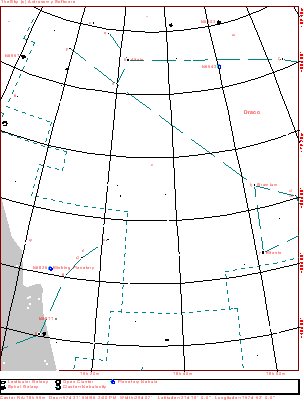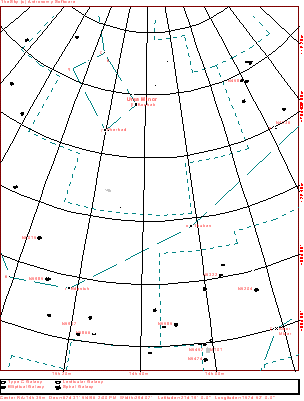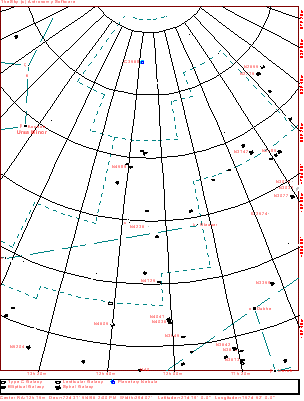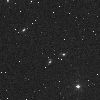
| Home | Deepsky Atlas | TheAstronews | Links | Solar System | ||||||

Hawaiian Astronomical SocietyConstellations: Draco -- The Dragon of many Stories |
||||||||||
Meanwhile, Herakles worked hard to accomplish his twelve labors, purging the sin of murdering his family. His 11th labor involved obtaining the golden apples. Ladon the dragon was a faithful guard, allowing only Atlas to approach him. Knowing this, Hercules made a deal with Atlas. We all have seen the pictures of Atlas forever holding the world on his shoulders. You may not know that Atlas grew tired of the task. Hercules offered to carry it for him while Atlas stole the apples, and Atlas delighted to oblige (Atlas forgot about his obligation to Zeus).
Ladon was napping when he heard the footstep of Atlas. He glanced at his master and went back to sleep. Atlas took the apples, and realized he no longer had to carry the Earth on his shoulders. He told Hercules he would deliver the apples himself. Hercules read Atlas' mind perfectly; he was a bit smarter than Atlas (more of an insult to Atlas than a complement to Hercules). He told Atlas he didn't mind carrying the globe, but first he would need to get a shoulder pad to rest it on. Atlas took back the globe without suspecting Hercules. Hercules quickly took the golden apples, laughed at Atlas, and left the garden. Too late Atlas realized the deception.
Hera and Zeus were enraged because the dragon failed to protect the golden apples (after all the dragon was the guardian of the apple, not Atlas). To punish the dragon, Hera placed the creature among the chilly circumpolar constellations to guard the heavens forever, never resting, never setting (the constellation sets here in Hawaii however....).
Click here for Herakles' twelfth and last labor.

Click the map for a 909x1199 version of the above. Click here for a map better suited for use in the field.

This a more detailed view of the constellation. The map displays stars to magnitude 10, and deepsky objects to magnitude 12. Click here for a map better suited for use in the field.

Click here for a map better suited for use in the field.

Click here for a map better suited for use in the field.

Click here for a map better suited for use in the field.

Click here for a map better suited for use in the field.
 116k GIF NGC6543 (Best 50, Caldwell 6) is a pretty mag. 9 planetary nebula described as very bright, small (5.8'), and brightening to the middle. It lies 5.1° ENE of Zeta Draconis. A bigger telescope than amateurs normally use (the Hubble) took this picture. Notes on the image follow. 116k GIF NGC6543 (Best 50, Caldwell 6) is a pretty mag. 9 planetary nebula described as very bright, small (5.8'), and brightening to the middle. It lies 5.1° ENE of Zeta Draconis. A bigger telescope than amateurs normally use (the Hubble) took this picture. Notes on the image follow.
This NASA Hubble Space Telescope color image shows one of the most complex planetary nebulae ever seen, NGC 6543, nicknamed the "Cat's Eye Nebula." Hubble reveals intricate structures including concentric gas shells, jets of high-speed gas and unusual shock-induced knots of gas. Estimated to be 1,000 years old, the nebula is a visual "fossil record" of the dynamics and late evolution of a dying star.
|
Image to the left is from the Digital Sky Survey. Image to the right is by Jere Kahanpää.
|
 35k Labeled JPEG. NGC5907 (Best 48) is an edge on spiral galaxy located in the southern main "body" region, 2.9° SSW of Edasich (Iota Draconis). It anchors a number of other galaxies all located within 1.5° of each other. Dreyer describes it as quite bright (mag. 11.3), very large (12.4'x1.4'), very moderately extended (p.a. 155°), and very gradually, then fairly abruptly brightening toward the middle. 35k Labeled JPEG. NGC5907 (Best 48) is an edge on spiral galaxy located in the southern main "body" region, 2.9° SSW of Edasich (Iota Draconis). It anchors a number of other galaxies all located within 1.5° of each other. Dreyer describes it as quite bright (mag. 11.3), very large (12.4'x1.4'), very moderately extended (p.a. 155°), and very gradually, then fairly abruptly brightening toward the middle.
NGC5879 lies 1.1° to the north-west. Dreyer says it is quite bright (mag. 12), small (4.2'x1.3'), extended (p.a. 0°), with a much brighter middle round nucleus. He calls it "resolvable," but any mottling requires very dark skies and large aperture. NGC5866 lies 1.4° WSW of NGC5907. It is a possible candidate for M102 (M101 in Ursa Major is the other one) and it matches Messier's description. Dreyer calls it very bright (mag. 11.3), quite large (4.6'x1.9'), fairly moderately extended in position angle 146°. It brightens gradually toward the middle. An 8" shows a stellar nucleus at higher magnifications. The galaxy shows a fairly easy dark lane in 12" on dark, steady nights.
A pair of galaxies lies 51' south of NGC5907. The first, NGC5908 (mag. 13, 3.3'x1.2', p.a. 154°), lies 13' ESE of the second, NGC5905 (mag. 12.6, 4.0'x2.6', p.a. 134°).
|
 88k JPEG NGC4319 is the brightest galaxy, located in the lower center of this image. More generally, you find it 5.6° north of Kappa Draconis. Dreyer calls it fairly bright (mag. 13), fairly small (3.1'x2.3'), very little elongated, with a pronounced, bright nucleus in its bar. The mag. 14.5 quasar Markarian 205 lies just south of the galaxy's nucleus. It is a background object. 88k JPEG NGC4319 is the brightest galaxy, located in the lower center of this image. More generally, you find it 5.6° north of Kappa Draconis. Dreyer calls it fairly bright (mag. 13), fairly small (3.1'x2.3'), very little elongated, with a pronounced, bright nucleus in its bar. The mag. 14.5 quasar Markarian 205 lies just south of the galaxy's nucleus. It is a background object.
NGC4386 sits .3° to the NE. Dreyer says it's fairly bright (mag. 12.6), quite large (2.8"x1.7'), little elongated, with a pronounced center. NGC4291 lies 6' NW of NGC 4319. It is fairly bright (mag. 12.3), very small (2'x1.7'), round, with little brightening toward the middle. Three stars follow it (i.e. lie to the east) in the field.
From the Digital Sky Survey.
|
 65k JPEG NGC4236 (Caldwell 3) is a very faint (mag. 9.7) extremely large (23'x6'), spiral galaxy, elongated in PA 162°. The core is much brighter than the rest. It sits 1.5° WSW of Kappa Draconis. From the Digital Sky Survey. 65k JPEG NGC4236 (Caldwell 3) is a very faint (mag. 9.7) extremely large (23'x6'), spiral galaxy, elongated in PA 162°. The core is much brighter than the rest. It sits 1.5° WSW of Kappa Draconis. From the Digital Sky Survey.
|
If you have any questions about the Hawaiian Astronomical Society
please
(link requires javascript).